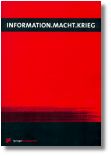 |





|
 |
 |
 Information.Macht.Krieg Information.Macht.Krieg
Ars Electronica 98
By
Gerfried Stocker and Christine Schöpf (eds.).
Springer
Verlag
Wien New York 1998
ISBN 3-211-83192-4
English Edition: Gerfried Stocker, Christine Schoepf (eds): Info
War. Vienna: Springer [ISBN 3-211-83191-6
Reviewed by Christina Teuthorn
Computer screens are the modern battle fields, future
soldiers store deadly ammunition - knowledge, information, data - on the
motherboard and launch deadly weapons with a mouse click. The arsenal
ranges from computer viruses to worms, trojan horses, logic bombs or nano
machines. Cyberwarriors, webterrorists, warbots, and Big Brother's eyes
are Info War protagonists, whose language, Pentagonese, is hard to
decipher: 21CLW, C3I, C4I2, OOTW.
When RAND strategists John
Arquilla and David Ronfeldt wrote the first draft of what resembled sci-fi
stuff in 1993, they couldn't know the speed of the ball they set rolling.
They were the first to formulate, in an illustrated and entertaining but
sometimes causality-lacking essay ("Cyberwar is coming!"), what would
become a new doctrine of warfare, one that a few years later is discussed
and modified in other terms like "Info War," "Electronic Warfare" or
"Netwar."
Their classic essay heads the other 24 contributions of
the Ars Electronica's Info War anthology. The essay's essence: tech-savvy
21st century belligerents will "conduct military operations according to
information-related principles" in a cyberwar, which "means disrupting if
not destroying information and communications systems." Highly developed
countries are extremely sensitive in their entire infrastructure,
organization, personnel, and components that collect, process, store,
transmit, display, disseminate, and act on information.
The
deterministic assumption that new information technologies will allow a
new species of warriors to target modern industrialised nations at
sensitive points is the common denominator of a third of the Ars
Electronica authors. The main problem is that they take an old essay, that
Arquilla and Ronfeldt themselves in the meantime have modified, as a basis
for discussion, and so produce redundancy: they cite the same sources, get
similar outcomes, and are mainly descriptive, not doubting the theoretical
framework.
One of the interesting parts is when George Stein and
Georg Schöfbänker's thorough description of how the Info War concept led
the Pentagon to modify its current "AirLand battle" doctrine's command
structure. The new structure C2W (Command and Control Warfare) has been
expanded by a communication-C, an intelligence-I, a computer-C and an
interoperability-I to finally reach its current form C4I2 (command,
control, communication, computation, intelligence and interoperability).
Other neologisms: the 21st century land warrior (21CLW) who in theory is a
completely electronically equipped command central, or the OOTWs
(operations other than war).
Besides the above mentioned critique
Ars Electronica meets the challenge of a serious debate on Info War topics
well. The anthology "Information. Macht. Krieg" presents the perspectives
of experts in theory and practice, and from a wide array of cultures and
nations. It also goes beyond western-dominated theoretical approaches and
includes less known perspectives like the futurologist and member of
Chinese National People's Congress Shen Weiguang's "Information Warfare -
A New Challenge," or Chinese dissident Wei Jincheng's illustration of a
"Volksinformationskrieg" (public information war). According to Weiguang,
the new pattern of war will be fought in an invisible sphere, will be
conducted without a fixed form and without any loss of blood. In six
thesis he develops a detailed scenario of what such a new type of war
could look like:
- Intelligence will be the dominating pattern
- Soft strikes are more important than hard ones
- The public becomes involved (as targets and participants), and so
the Information
- War turns a Public Information War
- War tactics shift from offense to defense
- Accurate commitments are impossible
- Info War resembles a conventional war: a country that owns the key
weapon has a first strike capability
Jincheng stresses point
three of Weiguang's argumentation, but he sees a chance in the new sort of
publicness for the people in closed regimes.
Other bonbons: Douglas
Rushkoff creates a non-military concept of an information arms race, where
everyday life is so penetrated by media-produced infojunk that you have to
take countermeasures against information overload. Online activists
extrapolate from their practical experiences. Geert Lovink (nettime) gives
strategies for techno-social movements, not how to better fight an Info
War, but how to have more control over media channels; Patrice Riemens
advises "Don't panic - hack it!" and describes his personal Info War for
more privacy; and the hacker organisation RTMark declares that the
existence of enemies in cyberspace is a product of cybercult-philosophy.
What makes the lecture less palatable: several essays, such as the
one on Silvio Berlusconi's television manipulation or the one on financial
markets and the Asia crisis, do not fit into the book's overall thematic
concept.
In sum, "Information. Macht. Krieg" provides a good
introduction to cyberwar and interesting insight into the theoretical
concepts and images conjured up of enemies and threatening scenarios.
Readers more familiar with the topic might have hoped for a more nuanced
Info War critique, more bonbons, and less conventional wisdom.
TOP
|
 |